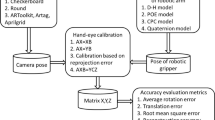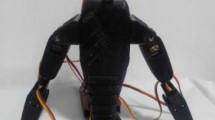Abstract
Despite its central role in the constitution of a truly enactive interface, 3D interaction through human full body movement has been hindered by a number of technological and algorithmic factors. Let us mention the cumbersome magnetic equipments, or the underdetermined data set provided by less invasive video-based approaches. In the present paper, we explore the recovery of the full body posture of a standing subject in front of a stereo camera system. The 3D position of the hands, the head and the center of the trunk segment are extracted in real-time and provided to the body posture recovery algorithmic layer. We focus on the comparison between numeric and analytic inverse kinematics approaches in terms of performances and overall quality of the reconstructed body posture. Algorithmic issues arise from the very partial and noisy input and the singularity of the human standing posture. Despite stability concerns, results confirm the pertinence of this approach in this demanding context.
















Similar content being viewed by others
Abbreviations
- IK:
-
Inverse kinematics
- PIK:
-
Prioritized inverse kinematics
- dof:
-
Degree of freedom
References
Badler NI, Hollick MJ, Granieri JP (1993) Real-time control of a virtual human using minimal sensors. In: Presence 2(1), MIT Press, Cambridge, pp 82–86. ISSN 1054-7460
Baerlocher P, Boulic R (2004) An inverse kinematic architecture enforcing an arbitrary number of strict priority levels. Visual Comput 20(6):402–417
Bodenheimer R, Rose C, Rosenthal S, Pella J (1997) The process of motion capture: dealing with the data. In: Proceedings of computer animation and simulation. Eurographics Association, pp 3–18
Boulic R, Mas R, Thalmann D (1996) A robust approach for the center of mass position control with inverse kinetics. J Comput Graph 20(5):693–701
Boulic R, Baerlocher P, Rodríguez I, Peinado M, Meziat D (2004) Virtual worker reachable space evaluation with prioritized inverse kinematics. In: Proceedings of the 35th international symposium on robotics, Paris, March 2004
Boulic R, Peinado M, Le Callennec B (2005) Challenges in exploiting prioritized inverse kinematics for motion capture and postural control. Lecture notes in artificial intelligence, Springer, Berlin Heidelberg New York
Bradski GR, Pisarevsky V (2000) Intel’s computer vision library. In: Proceedings of the IEEE conference on computer vision and pattern recognition, CVPR00, vol 2, pp 796–797
Chai J, Hodgins JK (2005) Performance animation from low-dimensional control signals. ACM Trans Graph 24(3):686–696
Grochow K, Martin SL, Hertzmann A, Popovic Z (2004) Style-based inverse kinematics. ACM Trans Graph 23(3):522–531
Horain P, Bomb M (2002) 3D model based gesture acquisition using a single camera. In: Proceedings of the sixth IEEE workshop on applications of computer vision, WACV02, pp 158–162
Jojic N, Turk M, Huang TS (1999) Tracking self-occluding articulated objects in dense disparity maps. In: Proceedings of the IEEE international conference on computer vision, ICCV99, vol 1, pp 123–130
Maciejewski AA (1990) Dealing with the ill-conditioned equations of motion for articulated figures. IEEE Comput Graph Appl 10(3):63–71
Moeslund TB, Granum E (2001) A survey of computer vision-based human motion capture. Comput Vis Image Underst 81(3):231–268
Molet T, Boulic R, Rezzonico S, Thalmann D (1999) An architecture for immersive evaluation of complex human tasks. IEEE Trans Rob Autom 15(3):475–485
O’Brien J, BodenHeimer RE, Brostow GJ, Hodgins JK (2000) Automatic joint parameter estimation from magnetic motion capture data. In: Proceedings of Graphics Interface, Morgan Kaufmann Publishers, Mosby, St. Louis, pp 53–60. ISBN 0-9695338-9-6
Sturman D (1998) Computer puppetry. IEEE Comput Graph Appl 18(1):38–45
Tolani D, Goswami A, Badler NI (2000) Real-time inverse kinematics techniques for anthropomorphic limbs. Graph Models 62(5):353–388
Unzueta L, Berselli G, Cazón A, Lozano A, Suescun Á (2005) Genetic algorithms application to the reconstruction of the human motion using a non-invasive motion capture. In: Multibody dynamics, ECCOMAS thematic conference, Madrid, Spain, 21–24 June 2005
Varona J, Buades JM, Perales FJ (2005) Hands and face tracking for VR applications. Comput Graph 29(2):179–187
Wang L, Hu W, Tan T (2003) Recent developments in human motion analysis. Pattern Recognit 36(3):585–601
Wren CR, Clarkson BP, Pentland AP (2000) Understanding purposeful human motion. In: Proceedings of the fourth IEEE international conference on automatic face and gesture recognition. IEEE Computer Society, Grenoble, pp 378–383. ISBN 0-7695-0580-5
Acknowledgments
We thank the reviewers for their constructive feedback. This work was partly supported by the European Union through the Networks of Excellence ENACTIVE and INTUITION. The project TIN2004-07926 of Spanish Government and the European Project HUMODAN 2001-32202 from UE V Program-IST have subsidized part of this work. J. Varona acknowledges the support of a Ramon y Cajal fellowship from the Spanish MEC.
Author information
Authors and Affiliations
Corresponding author
Rights and permissions
About this article
Cite this article
Boulic, R., Varona, J., Unzueta, L. et al. Evaluation of on-line analytic and numeric inverse kinematics approaches driven by partial vision input. Virtual Reality 10, 48–61 (2006). https://doi.org/10.1007/s10055-006-0024-8
Received:
Accepted:
Published:
Issue Date:
DOI: https://doi.org/10.1007/s10055-006-0024-8




